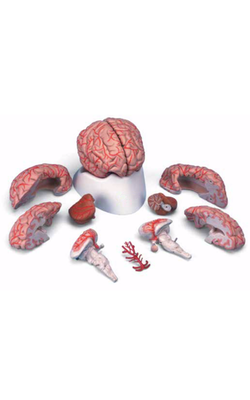Main Model

Cerebral arterial circle (Circle of Willis) : 7 Superior cerebellar artery

Vertebrobasilar System
The vertebrobasilar system is so named because it is formed
by the distal segments of the vertebral arteries as they join to
form the basilar artery. This portion of
the cerebrovascular system is the primary source of blood supply
to the brainstem.
Vertebral Artery
The vertebral artery is divided into four segments (V1 to V4) on the basis of its anatomic relationships. Segment
V1 is that portion located between its origin from the subclavian artery and the point where this artery enters the transverse
foramen of the sixth cervical vertebra. The second segment,
V2, is that portion of the vertebral artery that ascends through
the transverse foramina of C6 to C2. The third segment, V3, is
located between the exit of the artery from the C2 foramen and
the point where it penetrates the atlantooccipital membrane; this
includes the loop that passes through the transverse foramen of
C1 and arches caudally and medially around the lateral mass of
the atlas. The V4 segment passes through the
dura, is located within the cranial cavity internal to the atlantooccipital membrane and dura, and will join its counterpart to form
the basilar artery.
This circuitous segment of V4 is vulnerable to injury. For
example, hyperextension of the head may compress the vertebral
artery between the occipital bone and the posterior arch of the atlas, and extreme rotation of the head may put torsion on this
artery and restrict blood flow. The deficits seen in these patients
fall under a general classification referred to as vertebrobasilar
insufficiency. Once it is inside the subarachnoid space, the vertebral artery is located in the lateral cerebellomedullary cistern.
Branches of the vertebral artery supply the medulla, parts of
the cerebellum, and the dura of the posterior fossa. Its first major branch, the posterior inferior cerebellar
artery (PICA), arches around the posterolateral medulla and sends
branches to this part of the brainstem. Posteriorly the
PICA is located in the cisterna magna (dorsal cerebellomedullary
cistern). It serves the choroid plexus of the fourth ventricle and
then branches over medial parts of the inferior cerebellar surface. In about 75% of brains, the posterior spinal artery is a
branch of the PICA; in the other 25%, it arises from the vertebral
artery. The posterior spinal artery serves dorsolateral regions of
the medulla caudal to the area served by the PICA. The vertebral artery supplies the anterolateral medulla and, just
before joining its counterpart on the opposite side, gives rise to the
anterior spinal artery. This vessel usually (85% of cases) originates
as two small trunks, which join to form a single artery that courses
caudally in the ventral median fissure of the medulla and continues into the spinal cord. The anterior
spinal artery is found in the premedullary cistern.
Aneurysms of the vertebral artery or its major branches are
not common. When present, they are usually found where the
PICA branches from the vertebral artery.
Basilar Artery
The basilar artery lies in a shallow depression, the basilar sulcus, on the anterior surface of the pons in the prepontine cistern. Its first large branch, the anterior inferior
cerebellar artery (AICA), generally arises from the lower third of
the basilar artery and passes through the cerebellopontine cistern
as it wraps around the caudal aspect of the middle cerebellar
peduncle. The AICA serves ventral and lateral surfaces of the
cerebellum, parts of the pons, and the portion of choroid plexus
that extends out of the foramen of Luschka into the cerebellopontine angle. The labyrinthine artery is usually a
branch of the AICA. It arises close to the origins of the facial and
vestibulocochlear nerves and enters the internal acoustic meatus along with these nerves.
The basilar artery gives rise to numerous pontine arteries. These arteries may penetrate the pons immediately as paramedian branches, travel for a short distance around the pons as
short circumferential branches, or pass for longer distances as
long circumferential branches.
The last major branches of the basilar artery are the superior
cerebellar arteries. Just distal to their origin, each superior cerebellar artery divides into medial and lateral branches, which serve their respective regions of the superior surface of the cerebellum and most of the cerebellar
nuclei. These vessels pass laterally just caudal to the root of the
oculomotor nerve and wrap around the brainstem in the ambient
cistern to ultimately serve caudal parts of the midbrain and the
entire superior surface of the cerebellum.
Intracranial aneurysms on the vertebrobasilar system are frequently found in relation to the basilar bifurcation and may therefore involve the oculomotor nerve. In similar fashion, an aneurysm of the AICA may produce symptoms of facial or
vestibulocochlear nerve involvement because this vessel travels
adjacent to these nerves.